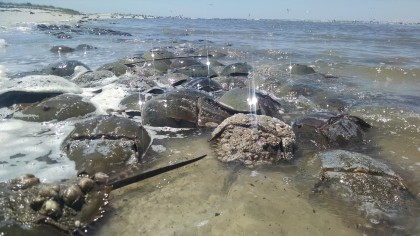
I’ve spent the last month, tide in, tide out, on Delaware Bay beaches. With the help of a great team, I’ve been monitoring horseshoe crabs, their eggs and the shorebirds eating the eggs. The work continues, but here a some photo highlights so far.
(click on any of the photos to enlarge)
Here are some newly arrived ruddy turnstones resting on the intertidal shell reef that was constructed at Reeds Beach back in April.
A least sandpiper beautifully blending into its preferred muddy/peaty foraging habitat (photo credit Mark Field).
A raucous new moon display of spawning horseshoe crabs at the newly restored Thompsons Beach. It is remarkable how well the crabs respond to fresh sand.
At the same place and time, lots of loose horseshoe crab eggs in the swash zone.
Elsewhere, a mysterious marsh hominid was observed. It reminds me of a Star Wars character.
Ruddy turnstones are not shy birds and will readily take advantage of man-made roosting spots.
A famous pair of willets that go by the name of Barney (left) and Betty (right), still together after all these years. We tracked both of them with geolocators. Betty was tracked twice and she carried the first geolocator we ever recovered.
Ruddy turnstones and a red knot roosting on a peaty shoreline.
The work: digging 8x8x8 inch holes in the sand to count horseshoe crab egg clusters. The roman numerals in the sand represent the number of cluster found in each hole.
A shoal of shorebirds at Fortescue.
On this day there was a half-mile ribbon of foraging shorebirds on the beach at Fortescue. Note the unoccupied space around the fishermen.
A worrying sight? This is salt cedar. A notorious invasive in the West. This one colonized a Delaware Bay beach.
And right now, terrapin season! Turtle activity exploded in late May.